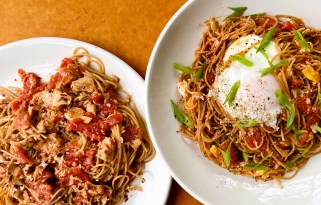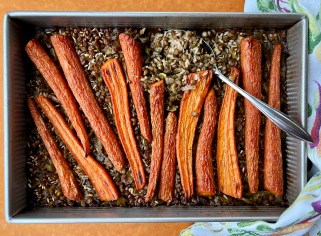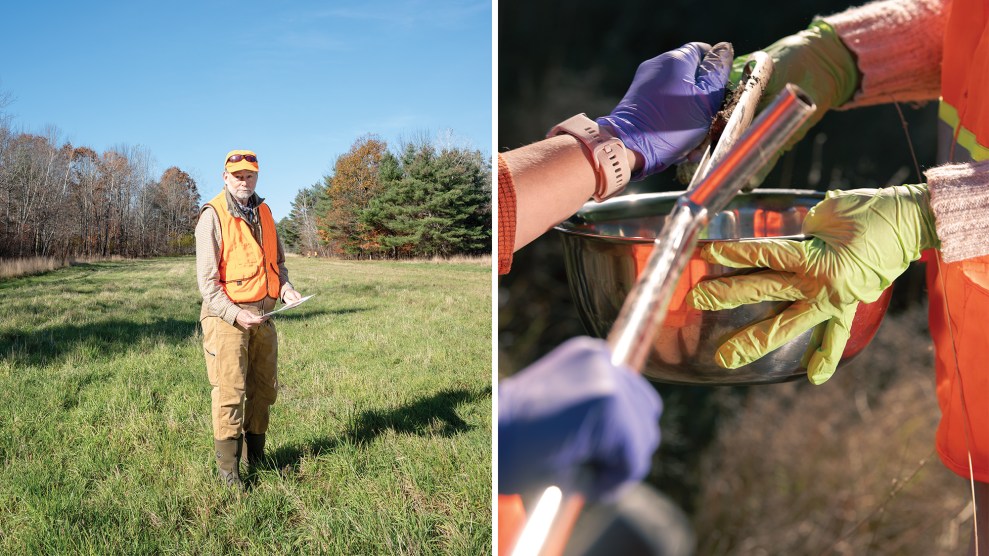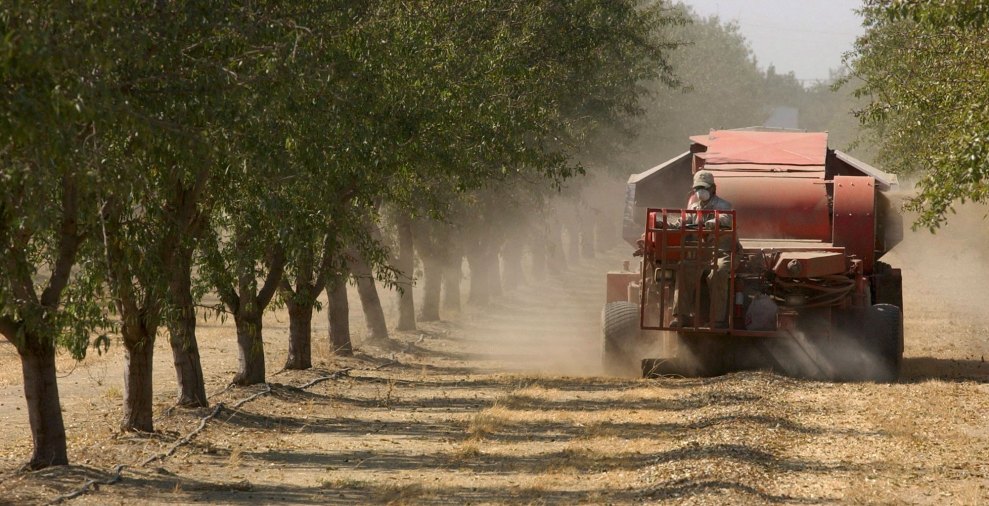
Kerri Conan
This article was produced by The Bittman Project and the Economic Hardship Reporting Project, which supports independent journalists as they forward fresh narratives about inequality. It is co-published here with permission. EHRP’s high-quality journalism is co-published with mainstream media outlets, to help readers understand and address systemic hardship.
Cooking and food shopping are very different in America than they used to be.
For one thing, there’s an often overwhelming “time tax” on many workers, leaving us with mere minutes for cooking–the average American has only about 39 minutes to devote to food preparation and clean up per day, according to the Bureau of Labor Statistics from 2022. (It’s still mostly mothers doing that cooking—80 percent as of 2019—and the shopping as well.) And if it isn’t time, it’s money: Groceries cost 25 percent more than they did 4 years ago; that’s considerably above the rate of inflation. And when we shop for vegetables, we sometimes have to “forget” that the regular kind are often grown with loads of chemicals: organic vegetables are simply too expensive—or not even available—at our local supermarkets. Recent layoffs across several important sectors have accelerated the growing income precarity of the people doing the cooking. Finally, it’s difficult to shop with the earth and animal welfare in mind when many of us are already on tight budgets.
Yet little of this has much impact on the way most recipes are written, and that needs to change.
We—this is a joint effort of the Economic Hardship Reporting Project and The Bittman Project—wanted to try to address all of these issues through some recipes that try to get at the complexity, cost, and conscience involved in making our meals. And we wanted to do that while avoiding the pitfalls of condescending cooking initiatives like the “Blue Apron-style” SNAP proposal of the Trump administration?
We believe the following recipes accomplish this well. We’re using fish and meat as condiments, or centering vegetables; these two strategies make dishes both cheaper and more conscientious. We’re also including links that explain the political, health, and animal justice context of certain ingredients. We’re offering substitutions for tricky, costly, or recherche ingredients. (While selecting the right fish may seem fraught with complexity, we demystify the process by offering a range of possibilities there, as well.) We’re also showing you the total cost of ingredients for each recipe, and suggesting uses for leftovers, so that nothing is wasted.
Recipes that take on board things like time, class, income, and sustainability may be few and far between. But they are, we believe, representative of how recipes should start to look.
How to Shop for Good Ingredients in Tough Times
Getting a meal on the table is an act of love and beauty. Grocery shopping maybe not so much. Here are six ideas for making the most efficient, economical, and sustainable choices while you dash through the supermarket.
1. Prioritize your purchases.
Whether you make a list or not, consider what is most important to you—be it fresh vegetables, beans, pasta, meat, or ice cream—and start at that part of the store.
2. Beware the hidden cost of sale prices.
Five pounds of boneless chicken at half price with a sell-by date of today only works if you have room in your freezer and time to bust the package up into usable portions, or a plan to cook and eat it right away. Better to look—and maybe wait—for value in something you’ve identified as a priority.
3. Pay attention to shelf tags.
This means reading some fine print. But details like price per pound can help you decide if a bulk purchase is worth the extra storage space or whether the brand name might actually be a better choice than the store label. Some supermarkets even tag WIC-eligible items on the shelf, and of course sales are always flagged, though not always prominently.
4. Be open to substitutions.
Maybe the recipe calls for asparagus, but the green beans look much better. Knowing how to adjust cooking times for substitute ingredients (as these recipes do) helps you take advantage of what’s in season, what’s on sale, and what you and those you cook for like best.
5. Beware of garnishes.
Pretty fresh herbs look great on social media. They’re just not always practical, given the cost, time it takes to prepare them, and potential for waste. A few good-quality dried herbs and spices are almost always a better value. (Unless you have a kitchen garden.) Here again, knowing how and when to make swaps helps. That and caring more about how something tastes than how it looks.
6. Consider sustainable choices whenever you can.
How and where our food is raised is crucial for the health of humans and our environment. But knowing how and when to buy organic and sorting through confusing labeling adds another layer to the work of cooking. Here are two tools to help you search ingredients while you’re shopping. For produce, the Environmental Working Group “Dirty Dozen” List includes “The Clean Fifteen” and all the fruits and vegetables in between. And for fish and shellfish, Seafood Watch is both helpful and comprehensive. Sorting through the terms of meat, poultry, and egg labels is a deeper dive. This site from the US Department of Agriculture is a good place to start.
One-Pot Pasta with Tomatoes and Eggs

Makes: 4 to 6 main-dish servings
Time: 30 minutes
Cost: $20 (not including salad or side vegetable and using previously purchased soy sauce; but with extra ingredients for the fridge and pantry)
Leftovers: Add the sauced pasta to beaten eggs and scramble or bake into a frittata. Or reheat in a hot skillet, stirring occasionally, until the noodles sizzle and crisp in places.
A sort of magic happens when you cook pasta and sauce together at the same time in a big pot, season it robustly, and toss in modest portions of economical proteins. The sauce forms right before your eyes, coating the noodles perfectly. It’s almost as fast as packaged mac-and-cheese, and we’d like to think way better in every way, except perhaps the nostalgia factor. Whole wheat pasta adds more fiber and nutrients than noodles made from durum wheat, and we like the way it tastes. Though of course we eat traditional pasta sometimes, too. This recipe makes a lot of food, but you’ll probably still want some simply cooked vegetables on the side, or maybe a salad.
Ingredients
4 scallions
4 tablespoons (1/2 stick) butter or neutral-tasting vegetable oil (like grapeseed or canola)
1 large can (28-ounces) whole tomatoes
Salt
1 pound spaghetti (or any pasta shape)
Pepper
6 eggs
Soy sauce for serving
Instructions
- Trim and rinse the scallions. Cut the green and white parts and chop them separately; set aside the green tops for garnish. Get at least 2 cups water ready by the stove.
- Put 2 tablespoons of the butter or oil in a large pot over medium heat. When it is hot, add the sliced white part of the scallions and cook, stirring occasionally, until they soften, just a minute or so. Stir in about 1 cup of water. Carefully take a tomato from the can, crush it with your hands and remove the tough core, and drop it into the pot. Repeat with the remaining tomatoes; then pour in the juice. (Or you can cut the tomatoes in the can with scissors or pour the whole can in at once and break them up with a potato masher in the pot.) Sprinkle the sauce with salt.
- Raise the heat to medium high. When the sauce comes to a boil, stir in the pasta, either whole or broken in half. Keep stirring and tossing until the noodles bend and soften, about 3 minutes. Then stir occasionally to keep them from sticking together. After a few more minutes, when the tomatoes break down and the pot gets dry, start adding water, 1/2 cup at a time, stirring after each addition. When the liquid is just about absorbed, add more. Keep the heat at medium, stir frequently, and repeat adding water as necessary; you’ll need almost all of the 2 cups you measured earlier.
- Begin tasting the pasta 10 minutes after you added it; the strands should be tender but have some firmness when you bite. (It could take as long as 15 minutes to reach this stage.) When the pasta is ready, stir in the remaining butter or oil and enough additional water to make the noodles glossy and thickly coated. Taste and add more salt and some pepper, spread the pasta into the bottom of the pot, and crack in the eggs.
- Cover the pot, remove it from the heat and let it sit until the yolks are as runny or solid as you like, 4 to 8 minutes. You can serve the eggs whole, or stir them into the noodles (or do a combination as shown in the photo). To serve, scoop out the noodles with a large spoon and tongs and garnish with the reserved scallion tops. Pass the soy sauce at the table.
Variations
One-Pot Pasta with Tomatoes and Tinned Fish. Substitute a small chopped onion for the scallions; you probably won’t need some or all of the butter or oil. Replace the eggs with 8 to 12 ounces canned or jarred fish packed in olive oil. If you like tuna, look for sustainably caught yellowfin, albacore (white), or skipjack (chunk light). Salmon, sardines, or mackerel are also good choices. In Step 1, start by opening the cans or jars and measuring the olive oil into the pot for cooking the onion. Then follow the recipe until Step 4 where you will add the tuna (or other fish) to the pot, along with a sprinkling of dried Italian seasoning blend and the remaining oil in the tin and more butter or olive oil if you need it. Instead of the soy sauce, pass red chili flakes at the table.
One-Pot Pasta with Tomatoes and Cheese. Substitute olive oil for the vegetable oil (or use butter). Instead of the eggs, crumble 8 ounces of a flavorful cheese, like feta or queso fresco, which have better quality and flavor than inexpensive Parmesan cheese. Add the cheese to the pot at the end of Step 4 along with a pinch of smoked paprika or chili powder.
One-Pot Pasta with Tomatoes and Leftovers. This recipe is a great place to use leftover bits of simply cooked roasted, grilled, or steamed meats; seafood; tofu; or vegetables. Just chop, slice, or shred whatever you have in the fridge—up to 2 cups. Add the leftovers to the pasta when you start tasting for doneness at the 10 minute mark in Step 4. You may need to add more butter or some olive oil. Skip the eggs but still cover the pot and let it sit at the end of that step so the extra bits heat through and the pasta is steaming hot when you serve it.
Recipes developed by The Bittman Project for the Economic Hardship Reporting Project
Warm Spring Vegetable Salad with Drumsticks and Crisp Croutons

About: 1 hour, including prep
Makes: 4 meal-size salads
Cost: $11.50 (not including olive oil or mustard)
Leftovers: Pull extra chicken from the bone and chop the cold vegetables; stir in some mayonnaise, if you like, for a sandwich.
The foundation of this one-skillet meal are chicken drumsticks, a flavorful, fast-cooking, and inexpensive cut that’s often on sale. But instead of cooking a lot of them, you use their rich pan drippings to crisp day-old bread into croutons for a warm vegetable salad. This less-meat-more-vegetable approach to eating—which is actually practiced throughout most of the world—treats animal protein as a seasoning. The results are satisfying, nourishing, and economical.
The recipe here also describes how to move ingredients in and out of a single pan as you prepare the components, so you’re busy but not frantic, and clean-up is easy. For the spring vegetables, choose your favorites from whatever looks best at the supermarket: asparagus, spinach, radishes (they’re delicious lightly cooked!), snap or sugar peas, or chard or romaine lettuce. Cook them just long enough to become crisp-tender—or keep going if you like your vegetables soft—toss in lemony-mustard dressing, nestle in a drumstick or two, and top with those delicious croutons.
Ingredients
1 small or 1/2 medium onion (any kind you like)
Salt to taste
11/2 to 2 pounds spring vegetables (see the recipe note for ideas)
1 lemon, halved
1 tablespoon mustard (Dijon, coarse grain, or yellow)
4 tablespoons olive oil
11/2 pounds chicken drumsticks (4 to 6, depending on the size)
4 to 8 slices slightly old bread, preferably whole wheat (or 4 buns or English muffins)
Pepper to taste
Instructions
- Prepare the vegetables before you start cooking and keep them separate as you work. Halve the onion in either direction and slice thinly; trim and rinse the vegetables or greens, then leave them whole or slice or chop as you like best. (You can do all this up to several hours before cooking; cover and refrigerate until it’s time to eat.) Cut the lemon and put it near the stove with the mustard, olive oil, and the measuring spoons.
- Put 1 tablespoon of the oil in a large skillet over medium heat. When it’s hot but not yet smoking, add the chicken and sprinkle with salt. Adjust the heat so the pieces sizzle without burning and cook undisturbed, until the skin browns and releases easily from the pan, 3 to 5 minutes. Continue to cook and turn the drumsticks often to help them brown in places all over, about 5 minutes more.
- Turn the heat to medium-low, add 1/3 cup water, and scrape up any browned bits from the bottom of the pan with a spatula. Cover and cook until the thickest part of a drumstick is no longer pink at the bone, 10 to 15 min. (Use a small knife to cut into one and peek.)
- While the chicken cooks, chop or tear the bread into bite-size bits. When the chicken is ready, move it to a plate, measure 2 tablespoons of the remaining tablespoons oil into the skillet with the drippings and return the pan to medium heat. Fry the bread, stirring and scraping almost constantly with a spatula, until the bread is crisp in some places but still soft in others, about 5 minutes. Transfer the croutons to a serving bowl and let sit.
- Rinse out pan if it’s got dark bits in the bottom and get 1/2 cup water handy by the stove. Set the skillet back on medium heat and add the remaining tablespoon of oil. Cook the onion first, stirring occasionally until it softens and starts to turn golden, about 3 minutes. Then add the vegetables, starting with the firmest vegetables first (like the radishes and asparagus) and ending with the tenderest greens. Cook and stir until the vegetables are a little bit crisper than you ultimately want them, 5 to 10 minutes depending on what you chose. To test, poke them with a fork often.
- Raise the heat to high and stir the water into the skillet. When it starts to steam and bubble away, turn off the heat. Squeeze the juice from the lemon halves into the pan, using your fingers or a strainer to catch the seeds. Add the mustard and stir until the dressing is combined. (It’s fine if it separates a little.) Taste and adjust the seasoning, adding more salt and pepper if you like. Serve with the chicken, passing the croutons at the table.
Variations
Warm Spring Vegetable Salad with Fish and Crisp Croutons. Substitute fish fillets about 1 inch thick for the chicken; the other ingredients stay the same. To choose fish that is sustainably caught or raised, you can search the Seafood Watch for recommendations. (Some stores also have reliable labeling.) Frozen is often a good option; to thaw it quickly, put it in a bowl of tap water in the sink for 15 to 30 minutes and use that time to prepare the vegetables. Cut or tear the bread as described in Step 4 before starting. When you’re ready to cook, pat the fish dry with a clean towel and cook it as described in Steps 2 and 3, only you’ll drastically reduce the cooking time. The browning stage will take about 1 minute per side, and after adding water and covering, the fish will be ready after 3 to 5 minutes simmering. Peek with a knife as described to check the inside–the fish is ready when it’s firm, opaque at the center, and flaky without looking dry. Transfer it to a plate and wash the pan well before continuing with the recipe with Step 4.
Warm Spring Vegetable Salad with Pork Chops and Crisp Croutons. You can simply swap 4 small or two large 1-inch thick bone-in or boneless pork chops for the chicken. The directions and visual cues remain the same.
Recipes developed by The Bittman Project for the Economic Hardship Reporting Project
Rice-and Lentil “Paella” in a Cake Pan

Makes: 4 meal-size servings, plus leftovers
Time: 20 minutes prep plus 1 hour roasting time
Cost: $20 (with extra olive oil, brown rice, lentils, and spice for the pantry)
Leftovers: Reheat servings of paella in a covered dish in the microwave. Or chop the carrots and toss them with the rice and lentils; add lemon juice or a spoonful of any vinegar for a quick, hearty salad to serve over greens.
You don’t need a paella pan—or even a broad, ovenproof skillet—to make this vegan spin on the national dish of Spain. The bulk of the action happens efficiently with a big pot on the stove and moves to an oblong cake pan in the oven. Then you walk away and do something else for a while. And instead of saffron, you get some everyday seasoning choices in the ingredient list below. Be sure to check out the meatless variations and list of seasonal vegetable ideas that follow. The lentils become creamy and form a bit of a sauce, but feel free to serve with a dollop of non-dairy (or dairy) yogurt, a squeeze from a wedge of fresh orange, or a splash of hot sauce or salsa. In other words, this recipe is easy to customize.
Ingredients
11/4 cups long-grain brown rice
11/4 brown lentils
2 large or 3 medium leeks (about 1 pound)
4 tablespoons olive oil
1 tablespoon spice (like curry or chili powder, za’atar, or a mix of cumin and smoked paprika)
11/2 pounds carrots (any size, with tops if possible)
3 tablespoons chopped carrot tops or fresh dill, for garnish (optional)
Instructions
- Heat the oven to 425°F. Get a 9- by 13-inch metal or ceramic cake pan handy. (No need to grease it.) Measure the rice and lentils into a strainer, and rinse under running water, working through with your hands to discard anything that doesn’t quite look like lentils or rice. Let the mixture sit to drain.
- Trim the leeks so some green parts remain. Slice them crosswise into 1/2 inch rounds; you should have 3 to 4 cups. Rinse the leeks under running water, working with your fingers to separate layers and dislodge any grit.
- If your carrots came with greens on top, pinch off a handful of the nicest ones and put them in a bowl of cold tap water to use for garnish later. Trim the carrots and scrub with a clean brush or scouring pad (or peel them if you prefer). Carefully split lengthwise any that are wider than 11/2 inches in half. Toss with 1 tablespoon of olive oil and the salt and pepper and let them sit on the cutting board.
- Put the remaining 3 tablespoons of the olive oil in a large pot over medium heat. When it’s shimmering, add the leeks and cook, stirring frequently, until they’re soft and beginning to color, about 3 minutes. Add the lentils and rice, the spice, and a big pinch of salt and stir constantly until the mixture is glossy and fragrant, about 1 minute. Stir in 4 cups water, raise the heat to high, and bring to a boil. Remove the pot from the heat.
- Use a ladle to transfer the mixture to the cake pan, scraping out the last bits with a rubber spatula. Put the pan in the oven and roast undisturbed for 45 minutes.
- When the time is up, peek under the carrots with a fork to grab a taste of the rice and lentils and check the pan for liquid. If the rice is still chalky at the center and the pan is dry, pour another cup of water over the top of the paella and return it to the oven to cook for another 15 minutes. (If you saved some carrot greens, drain and chop them.) The paella is ready when the rice is tender, the lentils are broken up, and the carrots are browned in spots. Serve hot or at room temperature, sprinkled with an extra dusting of salt and pepper (or scatter the carrot greens over the top if you have them.)
Variations
Rice-and-Tofu “Paella” in a Cake Pan. Instead of the lentils, put 1 pound firm or extra-firm tofu in a bowl or large glass measuring cup and crumble with your fingers or a fork. (You should have about 2 cups.) In Step 1 rinse the rice by itself. The rest of the recipe remains the same. You probably won’t need to add extra water when you check for doneness in Step 6.
Rice-and-Nut “Paella” in a Cake Pan. Instead of the lentils, increase the rice to 11/2 cups and chop 1 cup nuts—like peanuts, almonds, pistachios, walnuts, or cashews. In Step 1 rinse the rice by itself. The rest of the recipe remains the same. You probably won’t need to add extra water when you check for doneness in Step 6.
Changing Paella for the Seasons
Carrots are great on top of this paella all year long, but it’s always nice to take advantage of seasonal produce by changing the vegetable you roast on top. In winter, try 1-inch thick cabbage wedges or sliced celery root or parsnips. In spring, thickly sliced fennel or giant asparagus stalks are lovely, as is a heap of spinach leaves; they’ll cook down to almost form a crust. For summer, green beans, fresh cherry tomatoes, or wedges cut from ripe tomatoes of any size will concentrate and soften to the point of practically melting away. And in fall, broccoli or cauliflower florets, or whole or halved Brussels sprouts make a lovely vegan main dish for the Thanksgiving table.
—Recipes developed by The Bittman Project for the Economic Hardship Reporting Project
© 2024 Mark Bittman. All Rights Reserved.















